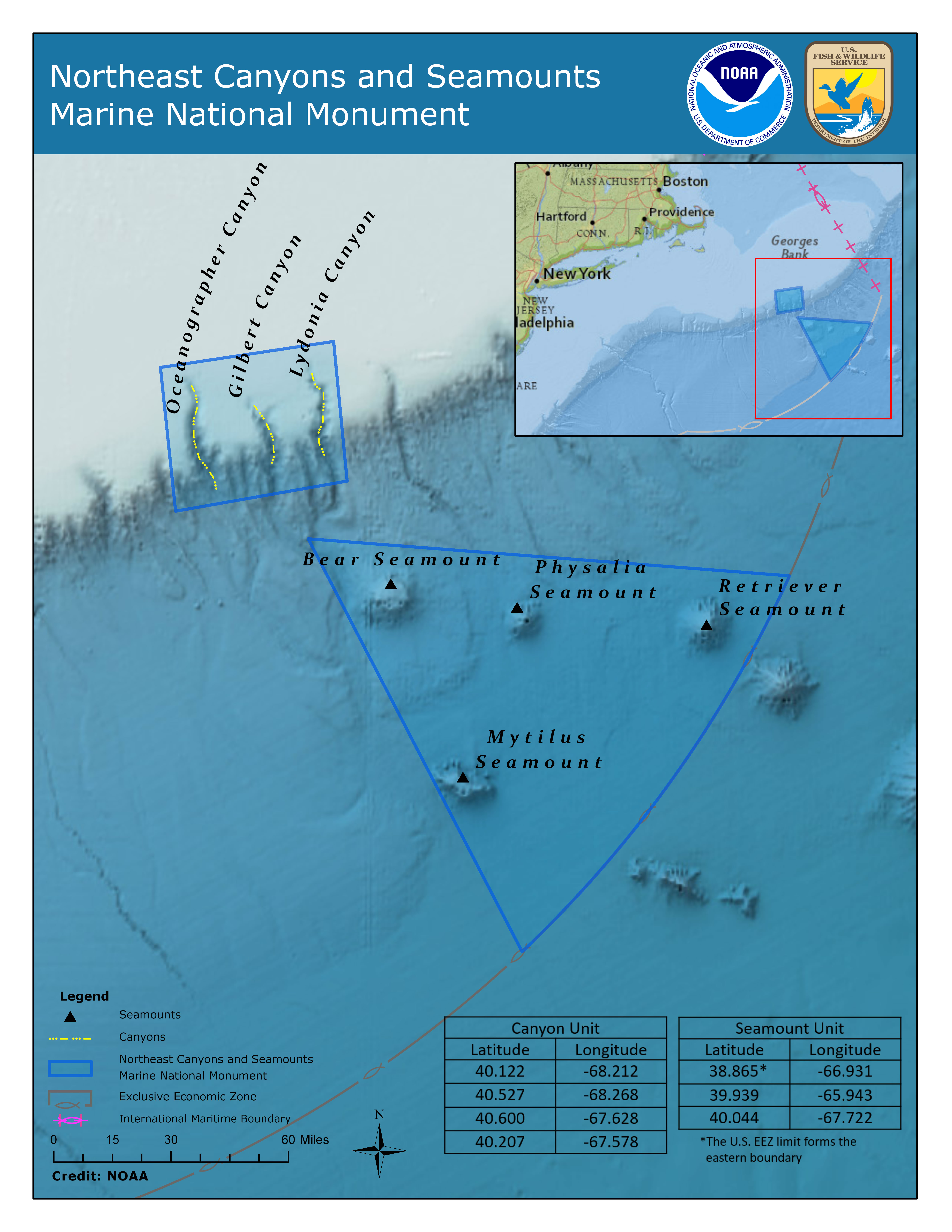
Image: A humpback whale swimming off the New England coast. Conservationists say the establishment of marine monuments not only protect endangered marine life, but can also benefit the fishing industry in the long run.
Last month, during a roundtable with Maine fishermen, U.S. President Donald Trump signed a proclamation to open the Northeast Canyons and Seamounts Marine National Monument to the fishing industry. Some fishermen claimed that restricting commercial fishing in the monument off the coast of New England endangered their livelihoods.
A key sentence in the proclamation declares:
“Whereas, I find that removing the restrictions on commercial fishing set forth in Proclamation 9496 to allow for well-regulated commercial fishing use is in the public interest and that the objects in the monument can be, and are currently, protected pursuant to carefully tailored regulation and management under existing Federal law:”
That statement would claim that opening the almost 5,000 square miles of Atlantic Ocean to commercial fishing would benefit the fishing industry and, if managed properly, would ensure that the area’s landscapes, fragile ecosystems, and rare and endangered species remain protected.
These claims are, in fact, false, some scientists say: Opening this monument to commercial fishing hurts fishermen — and the effective way to manage the marine monument is to halt commercial fishing.
“Opening a monument to fishing removes everything the monument is supposed to be. It leaves the monument in name,” said Dr. Enric Sala, National Geographic explorer-in-residence and founder of the National Geographic Pristine Seas program, who has helped create marine monuments. Additionally, he noted the presence of a marine reserve benefits fishermen as part of a balanced ecological and economic system.

Incorrect use of the Antiquities Act leads to lawsuit
Northeast Canyons and Seamounts lies about 130 miles off the east coast of the United States. The Barack Obama administration established it in 2016 as the first marine national monument in the country’s Atlantic waters.
Conservationists, including Maine-based marine scientist Zack Klyver and groups like the Natural Resources Defense Council and Center for Biological Diversity, are suing the Trump administration for misusing the 1906 American Antiquities Act. The Act gives the president the ability to establish monuments. Under the Constitution, though, only Congress has the ability to manage federal lands and roll back restrictions.
“A significant change to the monument or its protections — such as allowing commercial fishing — must be done by Congress, not by the president,” Brad Sewell, senior director of oceans for the Natural Resources Defense Council, said in a statement. “The Antiquities Act gives the president power to protect special areas for future generations, not the opposite power, to abolish those protections. Fishing poses a range of threats, such as harm to deep-sea corals from heavy fishing gear, and entanglement of bycatch and marine mammals.”
Correcting the misconception that marine monuments undermine the fishing industry
A conversation with Dr. Sala brought out a few important inaccuracies from the proclamation that require clarifying.
The monument doesn’t hurt fishermen. Dr. Sala emphasized that most fishing happens along the coastline — that includes the work done by Maine fishermen present at the roundtable. Fishing activity within that Atlantic area was modest before the monument designation, Dr. Sala said. The red crab and lobster fisheries that were using those waters were given until 2023 to move out of the area.
Highly protected areas improve fish catch. From larger yields to larger fish to greater diversity, protection benefits fishermen. A study conducted by Dr. Sala and Dr. Sylvaine Giakoumi of the University of Queensland found that fully protected marine areas have, on average, 670 percent greater fish biomass than nearby unprotected areas. Other research has shown that organism size increases by 25 percent and species richness by over 20 percent in marine reserves. These types of improvements have benefited fishermen near Marine National Monuments like the Hawaiian Papahanaumokuakea.
Around 99.9 percent of continental U.S. waters are open to the fishing industry. Only 0.1 percent of U.S. continental ocean waters are highly protected, Dr. Sala said. Research has shown that we need 30 percent of ocean environments to be highly protected by 2030 to improve climate resilience. This isn’t simply a vain exercise in preserving wildlife and beauty and withholding from commercial interests: Safeguarding the strength of these areas is vital for the health of the fishing sector as well.
It takes very little to disrupt fragile ecosystems. Even though minimal fishing was happening before the monument was established, even one net or trap dropping to the depths can do significant damage, Dr. Sala said. These ecosystems support leatherback and loggerhead turtles, 54 species of deep sea corals (some of which are thousands of years old) and canyons that attract the endangered sperm whale.
Fishermen are hurting, but not because of the monument
Of course, the fishermen at the president’s roundtable expressed economic woes and the fear that the monument sets a precedent for closing more of the ocean off to fishing interests.
Dr. Sala yet again emphasized that protecting the ocean is not a threat to fishing jobs. By contrast, the Trump administration has taken actions that do hurt the industry, he insisted. There has been a decrease in demand for seafood, which relates to collapsed supply chains. The trade war with China has led to increased tariffs that hurt the Maine lobster industry, for example.
Even the administration’s climate change policies — including pulling out of the Paris Climate Agreement and lifting environmental regulations for coal power plants — endanger fishing. Maine lobster are already moving north to colder waters.
Marine reserves are part of a healthy fishing sector. In addition to the challenges coming from federal measures, experts say New England waters are currently mismanaged and overfished. The Northeast Canyons and Seamounts Marine National Monument is part of the solution to restoring regional fish stocks and gaining much-needed resilience. A broader, more long-term view is necessary to see how the marine economic system actually works. With this holistic view, it is clear that the fishing sector doesn’t need deregulation — it needs increased marine protection.
Image credit: Todd Cravens/Unsplash

Roya Sabri is a writer and graphic designer based in Illinois. She writes about the circular economy, advancements in CSR, the environment and equity. As a freelancer, she has worked on communications for nonprofits and multinational organizations. Find her on LinkedIn.














